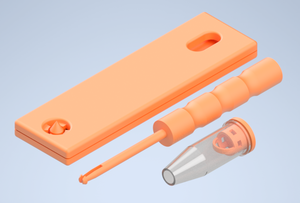
College of Engineering Unit:
Our project is AraFlow, a lateral flow device that detects trace amounts of the proteins Ara h2 and Ara h6 in food within minutes. Ara h2 and Ara h6 are the main proteins in peanuts that trigger severe allergic reactions. When creating AraFlow, we wanted to design a device that was accurate, sensitive, fast, inexpensive, and easy to use. So how does AraFlow work? Our device was inspired by commonly used lateral flow devices and uses an ELISA sandwich assay to detect peanut proteins. A small sample of food to be tested is placed in the sample processing vial via the sample collection wand and tip. A water based buffer solution in the vial then breaks down the sample, and releases any Ara h2 and h6 proteins into solution. Next, the vial is pressed onto the test card, releasing the solution onto a nitrocellulose lateral flow strip. As the solution flows down the strip, the Ara h proteins will bind to dye-tagged anti-Ara h antibodies at the beginning of the nitrocellulose strip. This dye will produce either one line for control– meaning that the food sample does not have Ara h2 or Arah6– or two lines–meaning that there are peanut proteins present. We believe that AraFlow can ensure food safety and confidence for those with severe peanut allergies.
Project Communication Piece(s):
| Attachment | Size |
|---|---|
| 667.35 KB |